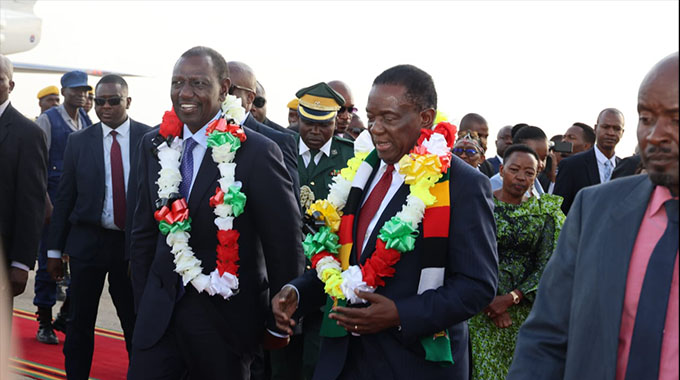Ngoma Buntibe: The orchestra of the BaTonga


BaTonga women donning bulumba on their noses play rattles, known as insaka during the First Lady’s rally in Binga last year
Pathisa Nyathi
This musical performance is, by all accounts, a fabulous musical presentation.
Listening to it is like listening to the pervasive sounds of creation of the universe. Viewing the dancers move around is akin to watching the rhythmic movement of cosmic bodies: stars, planets and moons. The music is scintillating and ear-caressing. This is a rendition of the music genre of the BaTonga called Ngoma Buntibe. The occasion is the installation of Nona Mungombe as Chief Siachilaba at a place in Binga District that goes by the name of the chieftainship.
Hundreds of people have gathered at Siachilaba Secondary School to witness the installation that is graced by the Minister of Rural Development Promotion and Preservation of Culture and Heritage, Cde Abednico Ncube and Cde Cain Ndabazekhaya Ginyilitshe Mathema, the Resident Minister for Matabeleland North. Other chiefs are also in attendance and they include Council of Chiefs president, Senator-cum-Chief Fortune Charumbira and his deputy Senator Chief Mtshane Khumalo, Chief Gampu IV Sithole and Chief Mathuphuma Khumalo.
The Siachilaba chieftainship belongs to the Bankuli family. In the whole district there are 17 chiefs, a reality that one finds expressed in the Ngoma Buntibe performance. The BaTonga people are a decentralised society with various communities each having its own chief. Apparently, each chief has several Ngoma Buntibe musical ensembles. David Mungombe, leader of the Siachilaba Musical ensemble called Simonga says there are four such groups under Chief Siachilaba. Chief Pashu also has four under his jurisdiction. One chief is said to have as many as 16 such groups in his area of jurisdiction. It is the prerogative of the chief to decide which group among the several under his custody will play during certain functions. Simonga has performed in Austria.
The Ngoma Buntibe musical band brings together a large number of performers, a minimum of 25 men and women. The energetic men, numbering about 12, play trumpets, nyele, made from horns of wild animals such as impala and kudu. The tapering ends of horns are used. The tips are cut off while the thicker ends are laced with wax from mpasi, a type of fly that makes honey in hollows in mopane trees. The wax is fixed to the thicker ends where the trumpeter blows. Mungombe says the wax protects the trumpeter’s lips. The raspy horn may cause abrasion to the lips. Different sizes of trumpets produce notes with different pitches. Blowing trumpets is a strenuous exercise and that explains why generally it is men who play the nyele.
In Africa the drum is an integral part of music. Ngoma Buntibe has about five drums made from a hard wood tree known as mukamba (mahogany). Drums fashioned out of mukamba do not shrink much and that maintains the required sound – its tone and pitch. Only skilled craftsmen are able to carve the drums. Some drums in use today are known to have been in existence from as far back as 1954. One such drum is known as kongorosi. The drums get names from what happens at the time when they are played. One drum was named chamunyona because it was played just when people were beginning to disperse and all immediately reassembled. This particular drum is found in Chief Pashu’s area. Another drum is called Pandamafuwa (the bone crusher).
Tonga drums are basically circular or cylindrical and have a smaller cylinder emerging from the bigger cylindrical section. The top end was hollowed out and a skin impaled over it using wooden pegs that jut out several centimetres from the drum. The drum skin that was traditionally used came from the ear of an elephant or the skin from the inner part of an elephant leg. Cow hide is used these days as elephants are protected by law. The drums vary in size from very big ones that women help carry around while men use sticks or hands to beat them to the smallest possible drum. The small drum is called katundundu or kagagaga.
Different sizes produce different pitches and complement the shrill and piercing sounds from the nyele. The big drum on the other hand is called nyina, the mother drum. During playing the drummers pause while the rest of the band players especially the trumpeters move on. Accomplished trumpeters stand out at this stage as it is difficult to maintain the right tune with drums excluded.
Rattles, known as insaka are played by women, some of them donning bulumba on their noses. In days gone by the calabash was used to make rattles. These days, however, metal tins containing some stone pebbles are used. Rattles accentuate the pitch and complement the other musical instruments in the musical orchestra.
Whistles, mpemba, complete the list of musical instruments. Traditionally plant seeds were used. The seeds were hollowed out and then players blew into the hollows. Alternatively, reeds, mwemba or mutetele were used. These days women whistle players use metallic or plastic whistles that they buy from stores.
Some of the musical instruments, notably the drums are embellished with decorative symbols whose meanings have been lost in the thick mists of history. The chevrons predominate. The chevrons are engraved on the wooden drums. Colour, derived from stone or plant bark, is introduced to make the chevrons stand out. Contrasting colours are quite exquisite and add some aesthetic dimension. The message in all the motifs is the same: continuity. It is the continuity of the Bankuli chieftainship, of the incumbent chief and his community.
One important attribute of the musical ensemble is constant movement. An elderly man holding a fly whisk, ijingo, made from muchilo (tail), leads the pack that follows him. The performers surround him and will, for a while, be stationed at one place before the nyele players detach themselves and move on, leaving behind drummers and other players taking a rest. The two sections rejoin and move on while playing their instruments. Women will, all the time, be singing. It is the women who play rattles that also sing.
Some of their songs have been very political. There have been songs about nationalist leader Joshua Nkomo and others that chided and ridiculed the white colonists Tanda mabunu kunyika yesu.
Also playing a part in the performance were men clutching a number of typical Tonga barbed spears and small shields. The men are demonstrating what Tonga warriors used to do as part of their martial arts. This movement of men and featuring the arms of war is known as kuzemba. A community had to be defended for it to continue to exist as a unit.
It is this constant movement of the musical orchestra with an identifiable centre that strikes one as cosmos imitated. Constant movement is characterised by constant change and that translates to continuity. Like cosmic movement the Ngoma Buntibe is played virtually nonstop. When they play during state functions the director of ceremonies has to keep a watchful eye on them lest they emulate the cosmos and perform eternally.








Comments